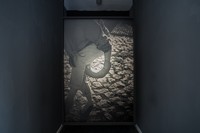
"UP IN ARMS", 2017
collaboration with Kathrin Sonntag
black and white slide projection, dimensions variable
Installation views at Conciergeraum, Salon Dahlmann, Berlin

"UP IN ARMS", 2017
collaboration with Kathrin Sonntag
black and white slide projection, dimensions variable
Installation views at Conciergeraum, Salon Dahlmann, Berlin

"UP IN ARMS", 2017
collaboration with Kathrin Sonntag
black and white slide projection, dimensions variable
Installation views at Conciergeraum, Salon Dahlmann, Berlin
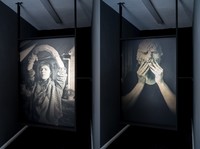
"UP IN ARMS", 2017
collaboration with Kathrin Sonntag
black and white slide projection, dimensions variable
Installation views at Conciergeraum, Salon Dahlmann, Berlin
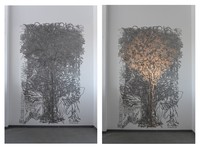
"Eva ́s Enlightenment", 2017
wall drawing, slides, dimensions variable, here about 1,5 x 2 meters, installation view

"Eva ́s Enlightenment", 2017
wall drawing, slides, dimensions variable, here about 1,5 x 2 meters, installation view and detail
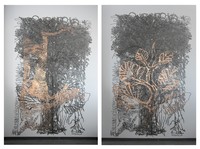
"Eva ́s Enlightenment", 2017
wall drawing, slides, dimensions variable, here about 1,5 x 2 meters, installation view

Installation view of "Ein Bild" (An Image) at Gallery Kadel Willborn, Düsseldorf, on the occasion of the PhotoWeekend 2017
Ein Bild (An Image), collaboration with Kathrin Sonntag
3-channel-slide show of 243 text, color and black and white slides, 2015
Press Release written by Akiko Bernhöft:
What happens to photographs of which you simply can't remember the reason for taking them? That's right. They disappear into the archive and carve out an existence there in secret.
In the collaborative work "Ein Bild" (An Image), however, those play the leading role: Sorted by jointly determined and stubbornly numbered categories Nina Hoffmann and Kathrin Sonntag scoured their extensive picture archives. The selected photographs allow a humorous glance into the two artist's practice. "Ein Bild" is fed by the perpetual production chain of seeing, recording, selecting or discarding. For example the category "An image that shows something other than what was intended”, addresses the accidental circumstances of the images; this "knapp-daneben" category ("close but no banana") allows to show something different, more spontaneous, rather weird. The slide show unfolds as a narration apart from ordinary conventions, revealing something hidden in two ways: the work is more than just images that normally aren't shown - the work deliberately plays with the interstices, gaps and overlaps which arise, when two artists each choose an image to a common subject. With "An Image" Nina Hoffmann and Kathrin Sonntag enter into a dialogue not only about their friendship, but about the act of making, seeing and showing photographs.
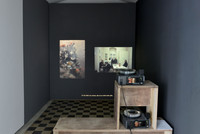
Installation view of "Ein Bild" (An Image) at the exhibition "Words and Images Drink the Same Wine" at After the Butcher-Ausstellungsraum für zeitgenössische Kunst und soziale Fragen, 2015
Ein Bild (An Image), collaboration with Kathrin Sonntag
3-channel-slide show of 243 text, color and black and white slides, 2015
Press Release written by Akiko Bernhöft:
What happens to photographs of which you simply can't remember the reason for taking them? That's right. They disappear into the archive and carve out an existence there in secret.
In the collaborative work "Ein Bild" (An Image), however, those play the leading role: Sorted by jointly determined and stubbornly numbered categories Nina Hoffmann and Kathrin Sonntag scoured their extensive picture archives. The selected photographs allow a humorous glance into the two artist's practice. "Ein Bild" is fed by the perpetual production chain of seeing, recording, selecting or discarding. For example the category "An image that shows something other than what was intended”, addresses the accidental circumstances of the images; this "knapp-daneben" category ("close but no banana") allows to show something different, more spontaneous, rather weird. The slide show unfolds as a narration apart from ordinary conventions, revealing something hidden in two ways: the work is more than just images that normally aren't shown - the work deliberately plays with the interstices, gaps and overlaps which arise, when two artists each choose an image to a common subject. With "An Image" Nina Hoffmann and Kathrin Sonntag enter into a dialogue not only about their friendship, but about the act of making, seeing and showing photographs.

Ein Bild (An Image), collaboration with Kathrin Sonntag
3-channel-slide show of 243 text, color and black and white slides, 2015
Text by Akiko Bernhöft:
What happens to photographs of which you simply can't remember the reason for taking them? That's right. They disappear into the archive and carve out an existence there in secret.
In the collaborative work "Ein Bild" (An Image), however, those play the leading role: Sorted by jointly determined and stubbornly numbered categories Nina Hoffmann and Kathrin Sonntag scoured their extensive picture archives. The selected photographs allow a humorous glance into the two artist's practice. "Ein Bild" is fed by the perpetual production chain of seeing, recording, selecting or discarding. For example the category "An image that shows something other than what was intended”, addresses the accidental circumstances of the images; this "knapp-daneben" category ("close but no banana") allows to show something different, more spontaneous, rather weird. The slide show unfolds as a narration apart from ordinary conventions, revealing something hidden in two ways: the work is more than just images that normally aren't shown - the work deliberately plays with the interstices, gaps and overlaps which arise, when two artists each choose an image to a common subject. With "An Image" Nina Hoffmann and Kathrin Sonntag enter into a dialogue not only about their friendship, but about the act of making, seeing and showing photographs.
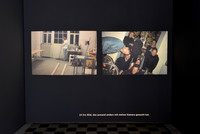
Ein Bild (An Image), collaboration with Kathrin Sonntag
3-channel-slide show of 243 text, color and black and white slides, 2015
Text by Akiko Bernhöft:
What happens to photographs of which you simply can't remember the reason for taking them? That's right. They disappear into the archive and carve out an existence there in secret.
In the collaborative work "Ein Bild" (An Image), however, those play the leading role: Sorted by jointly determined and stubbornly numbered categories Nina Hoffmann and Kathrin Sonntag scoured their extensive picture archives. The selected photographs allow a humorous glance into the two artist's practice. "Ein Bild" is fed by the perpetual production chain of seeing, recording, selecting or discarding. For example the category "An image that shows something other than what was intended”, addresses the accidental circumstances of the images; this "knapp-daneben" category ("close but no banana") allows to show something different, more spontaneous, rather weird. The slide show unfolds as a narration apart from ordinary conventions, revealing something hidden in two ways: the work is more than just images that normally aren't shown - the work deliberately plays with the interstices, gaps and overlaps which arise, when two artists each choose an image to a common subject. With "An Image" Nina Hoffmann and Kathrin Sonntag enter into a dialogue not only about their friendship, but about the act of making, seeing and showing photographs.

Ein Bild (An Image), collaboration with Kathrin Sonntag
3-channel-slide show of 243 text, color and black and white slides, 2015
Text by Akiko Bernhöft:
What happens to photographs of which you simply can't remember the reason for taking them? That's right. They disappear into the archive and carve out an existence there in secret.
In the collaborative work "Ein Bild" (An Image), however, those play the leading role: Sorted by jointly determined and stubbornly numbered categories Nina Hoffmann and Kathrin Sonntag scoured their extensive picture archives. The selected photographs allow a humorous glance into the two artist's practice. "Ein Bild" is fed by the perpetual production chain of seeing, recording, selecting or discarding. For example the category "An image that shows something other than what was intended”, addresses the accidental circumstances of the images; this "knapp-daneben" category ("close but no banana") allows to show something different, more spontaneous, rather weird. The slide show unfolds as a narration apart from ordinary conventions, revealing something hidden in two ways: the work is more than just images that normally aren't shown - the work deliberately plays with the interstices, gaps and overlaps which arise, when two artists each choose an image to a common subject. With "An Image" Nina Hoffmann and Kathrin Sonntag enter into a dialogue not only about their friendship, but about the act of making, seeing and showing photographs.
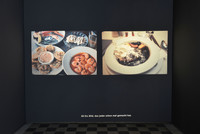
Ein Bild (An Image), collaboration with Kathrin Sonntag
3-channel-slide show of 243 text, color and black and white slides, 2015
Text by Akiko Bernhöft:
What happens to photographs of which you simply can't remember the reason for taking them? That's right. They disappear into the archive and carve out an existence there in secret.
In the collaborative work "Ein Bild" (An Image), however, those play the leading role: Sorted by jointly determined and stubbornly numbered categories Nina Hoffmann and Kathrin Sonntag scoured their extensive picture archives. The selected photographs allow a humorous glance into the two artist's practice. "Ein Bild" is fed by the perpetual production chain of seeing, recording, selecting or discarding. For example the category "An image that shows something other than what was intended”, addresses the accidental circumstances of the images; this "knapp-daneben" category ("close but no banana") allows to show something different, more spontaneous, rather weird. The slide show unfolds as a narration apart from ordinary conventions, revealing something hidden in two ways: the work is more than just images that normally aren't shown - the work deliberately plays with the interstices, gaps and overlaps which arise, when two artists each choose an image to a common subject. With "An Image" Nina Hoffmann and Kathrin Sonntag enter into a dialogue not only about their friendship, but about the act of making, seeing and showing photographs.
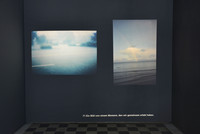
Ein Bild (An Image), collaboration with Kathrin Sonntag
3-channel-slide show of 243 text, color and black and white slides, 2015
Text by Akiko Bernhöft:
What happens to photographs of which you simply can't remember the reason for taking them? That's right. They disappear into the archive and carve out an existence there in secret.
In the collaborative work "Ein Bild" (An Image), however, those play the leading role: Sorted by jointly determined and stubbornly numbered categories Nina Hoffmann and Kathrin Sonntag scoured their extensive picture archives. The selected photographs allow a humorous glance into the two artist's practice. "Ein Bild" is fed by the perpetual production chain of seeing, recording, selecting or discarding. For example the category "An image that shows something other than what was intended”, addresses the accidental circumstances of the images; this "knapp-daneben" category ("close but no banana") allows to show something different, more spontaneous, rather weird. The slide show unfolds as a narration apart from ordinary conventions, revealing something hidden in two ways: the work is more than just images that normally aren't shown - the work deliberately plays with the interstices, gaps and overlaps which arise, when two artists each choose an image to a common subject. With "An Image" Nina Hoffmann and Kathrin Sonntag enter into a dialogue not only about their friendship, but about the act of making, seeing and showing photographs.
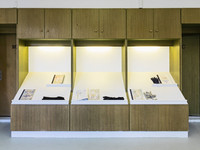
Installation view Re-Discovery II, Autocenter Berlin, 2014
Photo: Roman März, Berlin
Planet Earth Is Blue And There Is Nothing I Can Do, 2014
magazines, marker, transparent paper
Edition of 5 (each unique)
The five-part work on paper Planet Earth Is Blue and There Is Nothing I Can Do investigates the reality of equal rights in today’s world. To this end, the artist conducted a study of magazines to ascertain the respective presence of men and women. The naming of a man’s name or the picture of a male person Hoffmann coloured blue, while that of a woman she coloured red, so arriving at a result and conclusion clearly stated in the title of her work.
excerpt of the press realease by Janneke de Vries
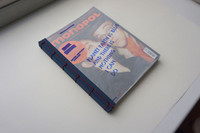
Planet Earth Is Blue And There Is Nothing I Can Do, 2014
magazines, marker, transparent paper
Edition of 5 (each unique)
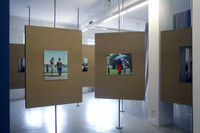
Ich brauche wenig Wirklichkeit (I rarely need reality), 2014
7 color and black and white prints on revolvable walls, print sizes approx. 70 x 50 cm, book
Installation view "Ich brauche wenig Wirklichkeit" at Gesellschaft für Aktuelle Kunst GAK Bremen, 2014
Aus dem Begleittext der Austellung: Den Auftakt macht die zweiteilige Arbeit Ich brauche wenig Wirklichkeit, die der Ausstellung ihren Titel gibt, es handelt sich um eine Fotoserie mit begleitendem Buch. Dafür hat Nina Hoffmann Personen, in die sie einmal unglücklich verliebt war, aufgesucht und mit ihnen Gespräche geführt, um einen Abgleich zwischen (ihren) Wunschbildern und der gelebten Realität vorzunehmen. Die Interviews sind in einer Publikation zusammengefasst, die mit in die Ausstellung genommen werden kann. Ergänzend verstellen im Eingangsbereich der Präsentation mehrere Drehwände den Besucher/innen den Weg. Sie dienen als Displays für Fotografien, die von Hoffmann nachinszenierte Sehnsuchtsmomente der unterschiedlichen, unerfüllten Beziehungen mit den betreffenden Personen zeigen. Um ihren Weg durch das Werk und in die Ausstellung zu finden, müssen die Besucher/innen die Drehwände bewegen und werden somit zu Mitgestalter/innen der Installation. Dadurch verlässt die Arbeit die rein biografische Ebene, kreist nicht mehr um intime Momente aus dem Leben der Künstlerin, sondern bezieht uns alle ein mit unseren Erfahrungen und den Bildern, die wir in uns tragen.
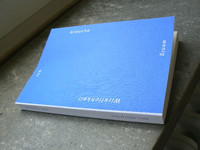
Ich brauche wenig Wirklichkeit (I rarely need reality), 2014
This book is part of the foto series "Ich brauche wenig Wirklichkeit"(I rarely need reality) and was given to every visitor of the exhibition "Ich brauche wenig Wirklichkeit" at Gesellschaft für Aktuelle Kunst GAK Bremen
Layout: Roland and Michael Brauchli
AVAILABLE AT MOTTO BERLIN
Skalitzer Straße 68, Backyard
10997 Berlin

Ich brauche wenig Wirklichkeit (I rarely need reality), 2014
7 color and black and white prints on revolvable walls, print sizes approx. 70 x 50 cm, book
Installation view "Ich brauche wenig Wirklichkeit" at Gesellschaft für Aktuelle Kunst GAK Bremen, 2014
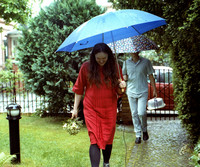
Ich brauche wenig Wirklichkeit (I rarely need reality), 2014
Detail
7 color and black and white prints on revolvable walls, print sizes approx. 70 x 50 cm, book
Installation view "Ich brauche wenig Wirklichkeit" at Gesellschaft für Aktuelle Kunst GAK Bremen, 2014

Ich brauche wenig Wirklichkeit (I rarely need reality), 2014
7 color and black and white prints on revolvable walls, print sizes approx. 70 x 50 cm, book
Installation view "Ich brauche wenig Wirklichkeit" at Gesellschaft für Aktuelle Kunst GAK Bremen, 2014

Ich brauche wenig Wirklichkeit (I rarely need reality), 2014
Detail
7 color and black and white prints on revolvable walls, print sizes approx. 70 x 50 cm, book
Installation view "Ich brauche wenig Wirklichkeit" at Gesellschaft für Aktuelle Kunst GAK Bremen, 2014

Ich brauche wenig Wirklichkeit (I rarely need reality), 2014
7 color and black and white prints on revolvable walls, print sizes approx. 70 x 50 cm, book
Installation view "Ich brauche wenig Wirklichkeit" at Gesellschaft für Aktuelle Kunst GAK Bremen, 2014

Ich brauche wenig Wirklichkeit (I rarely need reality), 2014
Detail
7 color and black and white prints on revolvable walls, print sizes approx. 70 x 50 cm, book
Installation view "Ich brauche wenig Wirklichkeit" at Gesellschaft für Aktuelle Kunst GAK Bremen, 2014
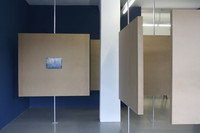
Ich brauche wenig Wirklichkeit (I rarely need reality), 2014
7 color and black and white prints on revolvable walls, print sizes approx. 70 x 50 cm, book
Installation view "Ich brauche wenig Wirklichkeit" at Gesellschaft für Aktuelle Kunst GAK Bremen, 2014
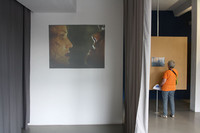
Installation view "Ich brauche wenig Wirklichkeit" at Gesellschaft für Aktuelle Kunst GAK Bremen, 2014
Right: Ich brauche wenig Wirklichkeit (I rarely need reality), 2014
7 color and black and white prints on revolvable walls, print sizes approx. 70 x 50 cm, book
Left: You Kiss By The Book, 2014, Video, 14:43 min, Loop, Composition: Filip Caranica
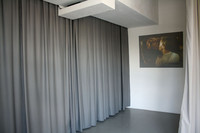
Installation view "Ich brauche wenig Wirklichkeit" at Gesellschaft für Aktuelle Kunst GAK Bremen, 2014
You Kiss By The Book, 2014, Video, 14:43 min, Loop, Composition: Filip Caranica
Aus dem Begleittext der Ausstellung: Wie sehr unsere Vorstellungen von Liebe, zwischenmenschlichen Beziehungen und Leidenschaft von Stereotypen bestimmt werden, thematisiert die anschließende Projektion You Kiss By The Book. Sie zeigt Ausschnitte aus Hollywoodblockbustern und reiht deren Kussszenen zu einem gefühlt unendlichen Loop aneinander: Richard Gere küsst Julia Roberts küsst Edward Harris küsst Mary Elizabeth Mastrantonio küsst Kevin Costner küsst Jennifer Aniston usw. Die Tonspur des Filmes besteht aus einem eigens komponierten Lied – eine einfache Melodie, die von Nina Hoffmann wie bei einer Probe mitgesummt und leise gesungen wird, inklusive kleiner Tonwackler oder Verspieler des Pianisten. Der Ausdruck „You kiss by the book“ beschreibt einen Zustand, etwas vorschriftsmäßig, wie auswendig gelernt, nach Schema F zu tun. Neben den Vorbildern, die uns Hollywood als Liebe vorgibt, wird hier der Leistungsdruck formuliert, der sich selbst in zwischenmenschlichen Bereichen einschleichen kann: „Sehe ich gut aus?“, „Küsse ich gut?“, „Bin ich gut im Bett?“ , „Bin ich klug/lustig/sympathisch genug?“ etc.
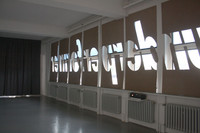
Underperformer, 2014
Installation: slides, pedestal, MDF panels
Installation view "Ich brauche wenig Wirklichkeit" at Gesellschaft für Aktuelle Kunst GAK Bremen, 2014
Der englische Ausdruck Underperformer bedeutet so etwas wie „Versager“, „Jemand, der seine Performance nicht bringt“. Er steht damit für eine Leistungsbeurteilung, die sich nicht ausdrücklich auf ein Ergebnis konzentriert, sondern die Art und Weise einbezieht, wie man sich darstellt, wie man „performt“, welchen Anschein man bietet. Den Anschein von etwas formuliert auch der zweite Teil der Arbeit: Auf zwei einander gegenüberliegenden Wänden zeigt sich das Schattenbild einer Mannes in klassischer Pose, die Hände in den Hosentaschen. Ein leerer, antikisierender Sockel steht in der Mitte des Raumes. Er ist so konzipiert, dass sein Schattenbild sich mit den beiden Wandprojektionen verbindet. Das Ergebnis sind die Projektionen einer männlichen Figur in zwei unterschiedlichen Perspektiven auf einem idealisierenden Podest, das tatsächliche Podest dagegen ist verlassen.
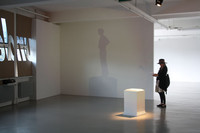
Underperformer, 2014
Installation: slides, pedestal, MDF panels
Installation view "Ich brauche wenig Wirklichkeit" at Gesellschaft für Aktuelle Kunst GAK Bremen, 2014
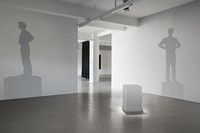
Underperformer, 2014
Installation: slides, pedestal, MDF panels
Installation view "Ich brauche wenig Wirklichkeit" at Gesellschaft für Aktuelle Kunst GAK Bremen, 2014
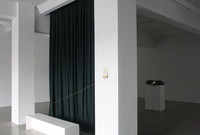
Installation view "Ich brauche wenig Wirklichkeit" at Gesellschaft für Aktuelle Kunst GAK Bremen, 2014
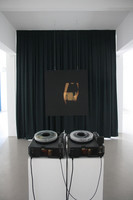
Alle Lust Will Ewigkeit (every lust seeks eternity), 2013
2-channel slide projection in daylight, 160 color slides, size variable
Installation view "Ich brauche wenig Wirklichkeit" at Gesellschaft für Aktuelle Kunst GAK Bremen, 2014
Aus dem Begleittext zur Ausstellung: Ebenfalls mit idealisierenden Wunschbildern und der Unmöglichkeit ihrer Erreichbarkeit beschäftigt sich Alle Lust will Ewigkeit im letzten Ausstellungsteil. Ausgangspunkt war hier die Sage von Pygmalion, der sich in eine von ihm selbst geschaffene Frauenstatue verliebt. In Alle Lust will Ewigkeit sind es im Umkehrschluss antike Männerskulpturen, deren Bilder an die Wand geworfen werden. Neben ihnen ist eine Projektion der Künstlerin Nina Hoffmann zu sehen, die versucht, nach dem Ideal (also der Statue) zu greifen. Doch diese entzieht sich ihrer Berührung, indem ihre Darstellung auf der Wand langsam verblasst.

Alle Lust Will Ewigkeit (every lust seeks eternity), 2013
2-channel slide projection in daylight, 160 color slides, size variable
Installation view "Ich brauche wenig Wirklichkeit" at Gesellschaft für Aktuelle Kunst GAK Bremen, 2014
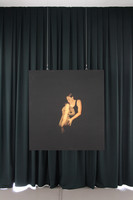
Alle Lust Will Ewigkeit (every lust seeks eternity), 2013
2-channel slide projection in daylight, 160 color slides, size variable
Installation view "Ich brauche wenig Wirklichkeit" at Gesellschaft für Aktuelle Kunst GAK Bremen, 2014
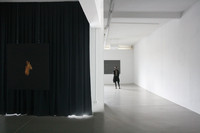
Installation view "Ich brauche wenig Wirklichkeit" at Gesellschaft für Aktuelle Kunst GAK Bremen, 2014
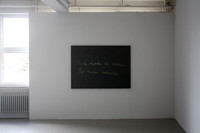
Meine Haare sehen wie ein Kornfeld aus, 2014
digital slide projection on graphite, 21 slides, size variable
Installation view "Ich brauche wenig Wirklichkeit" at Gesellschaft für Aktuelle Kunst GAK Bremen, 2014
Aus dem Begleittext zur Ausstellung: Die Projektion Meine Haare sehen wie ein Kornfeld aus fügt Zitate aus gefundenen Postkarten hintereinander und lässt so ein Portfolio typisch menschlicher Themen entstehen, das sich aus „Freundschaft“, „Schicksalsschlägen“ „Liebe“ oder „Sehnsucht“ zusammensetzt.

Meine Haare sehen wie ein Kornfeld aus, 2014
digital slide projection on graphite, 21 slides, size variable, detail
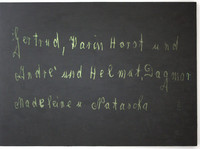
Meine Haare sehen wie ein Kornfeld aus, 2014
digital slide projection on graphite, 21 slides, size variable, detail

Meine Haare sehen wie ein Kornfeld aus, 2014
digital slide projection on graphite, 21 slides, size variable, detail

Aller Anfang, 2014
original postcards, small pedestals, posters 60 x 40 cm
Installation view "Ich brauche wenig Wirklichkeit" at Gesellschaft für Aktuelle Kunst GAK Bremen, 2014
Aus dem Begleittext zur Ausstellung: Auf einer blauen Wand finden sich angefangene, nicht zu Ende geschriebene Postkarten, die Nina Hoffmann über eine längere Zeitspanne gesammelt hat. Ihre beschriebene Seite kehrt sich den Betrach-ter/innen zu und bleibt so lesbar, ihre Bildseite wurde groß abgezogen und als hinterfassender Grund auf die Wand gebracht
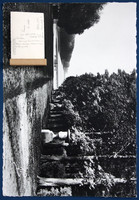
Aller Anfang, 2014
original postcards, small pedestals, posters 60 x 40 cm
Detail
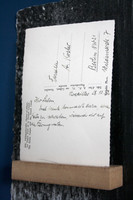
Aller Anfang, 2014
original postcards, small pedestals, posters 60 x 40 cm
Detail
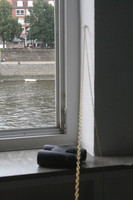
Achim, 2014
Installation: original postcard, small pedestal, chain, binoculars, boat
Installation view "Ich brauche wenig Wirklichkeit" at Gesellschaft für Aktuelle Kunst GAK Bremen, 2014
Mit der Arbeit Achim markiert Nina Hoffmanns Ausstellung den Sprung aus der Ausstellungsinstitution in den Außenraum. Ein Fernglas auf der Fensterbank der GAK animiert zum Blick nach draußen, auf die Weser. Genau gegenüber, auf der anderen Flussseite, liegt ein kleines, weißes Ruderboot zwischen den Bremer Ausflugsschiffen vertäut. Wer durch das Glas schaut, wird den Namen des Bootes entziffern können: „Achim“. Er markiert zum einen den Wechsel menschlicher Befindlichkeiten, wie sie im gesamten Verlauf der Ausstellung durchgespielt wird, in etwas Anderes, etwas Dingliches. Oder anders: Menschliche Befindlichkeiten werden durch die Namensgebung an das Dingliche gekoppelt, in das Dingliche übertragen. Um so mehr, als sich der Name nachvollziehbar herleitet aus einer Postkarte, die die Sorge um einen Freund zum Ausdruck bringt und eine Situation beschreibt, deren Ende wir nicht kennen...

Achim, 2014
Installation: original postcard, small pedestal, chain, binoculars, boat
Installation view "Ich brauche wenig Wirklichkeit" at Gesellschaft für Aktuelle Kunst GAK Bremen, 2014
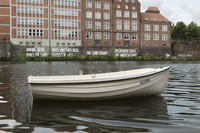
Achim, 2014
Installation: original postcard, small pedestal, chain, binoculars, boat
Installation view "Ich brauche wenig Wirklichkeit" at Gesellschaft für Aktuelle Kunst GAK Bremen, 2014
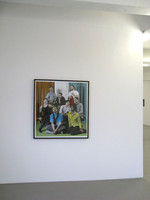
Gruppenbild mit Dame, 2011, hand-colored black and white print, 120 x 100 cm
Installation view "Girls Can Tell", Gesellschaft für Aktuelle Kunst (GAK), Bremen, 2013/14
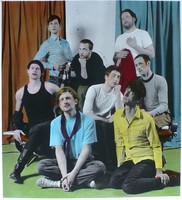
Gruppenbild mit Dame, 2011, hand-colored black and white print, 120 x 100 cm
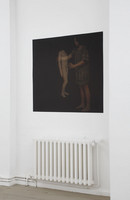
Alle Lust Will Ewigkeit (every lust seeks eternity), 2013
2-channel slide projection in daylight, 160 color slides, size variable
Installation view of the exhibition "Male Nudes - Female Desires" at Tanja Wagner Gallery, Berlin
Der Mensch malt, formt und be-greift durch sein Abbild nicht nur sich selbst, sondern spiegelt sich im Anderen. Sein Gegenüber, bildet den Widerpart zum eigenen Antlitz und fragt danach , wer wir sind. Gerade in der griechischen Skulptur mit seinen Götter- und Athleten-Figuren, fächert sich ein ganzer Kanon dazu auf, was als ideal galt und immer noch die Grundlage unseres ästhetischen Empfindens bildet.
So wird auch in der Pygmalion-Sage die Geschichte eines Künstlers erzählt, der sich auf Grund seines ewig gebrochenen Herzens, eine ideale Frau aus Marmor meißelt. Er verliebt sich in sie und bittet die Götter darum, sie zum Leben zu erwecken. Gemeinhin wird diese Geschichte als Allegorie zum Verhältnis von Künstler und Kunstwerk gelesen. Im Zentrum der Erzählung steht jedoch an erster Stelle die sehnsuchtsvolle Schaffung eines Ideals, welches dazu verdammt ist, Stein zu bleiben und allein durch höhere Mächte zum Leben erweckt werden kann.
Nina Hoffmann fragt in ihrer Diaserie “Alle Lust Will Ewigkeit” nach dem, was sich hinter den Idealen an Vorstellungen offenbaren. Sie begegnet männlichen Skulpturen der klassischen Antike auf Augenhöhe und setzt sich mit ihnen in Verbindung, was mal zögerlich, mal ganz direkt oder auch humorvoll geschehen kann. Die erhabenen Symbolträger dienen ihr als Vorlage, um etwa einer Siegerpose zu huldigen oder den erotischen Implikationen der Figuren als Frau entgegen zu treten.
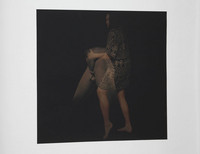
Alle Lust Will Ewigkeit (every lust seeks eternity), 2013
2-channel slide projection in daylight, 160 color slides, size variable
Installation view of the exhibition "Male Nudes - Female Desires" at Tanja Wagner Gallery, Berlin

Alle Lust Will Ewigkeit (every lust seeks eternity), 2013
2-channel slide projection in daylight, 160 color slides, size variable
Installation view of the exhibition "Male Nudes - Female Desires" at Tanja Wagner Gallery, Berlin
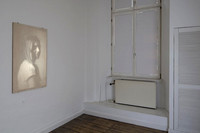
Potential K, 2011, 41 color and black and white slides, dimensions variable, installation view exhibition "wo sind wir jetzt" with Andreas Koch at Kunstverein Arnsberg, 2013
Potential K (2011) is a slide show whose photographs were taken over the course of eleven years. The multifaceted portrait of a friend of the artist’s focuses on the trusting intimacy between the two of them. This piece asks what insight we gain through the portrait of someone who shares a close relationship with the portrayer.
Für ihre Dia-Serie „Potential K“ versammelt Hoffmann Aufnahmen von einer nahen Freundin: Portrait-Aufnahmen, Schnappschüsse und Studiofotos aus den letzten elf Jahren. Immer wieder in Hoffmanns Arbeit speisen sich die Bilder aus ihrem Fotoarchiv, welches sie als lebendiges Materiallager ständig aufs Neue durchforstet. „Potential K“ ist der Versuch, das Portrait als Genre durch Mannigfaltigkeit zu erweitern und der Repräsentation des einen Wahren zu widersprechen. Die Arbeit scheint zu sagen: wir sind viel, jeder Einzelne von uns.

Potential K, 2011, 41 color and black and white slides, dimensions variable, installation view exhibition "wo sind wir jetzt" with Andreas Koch at Kunstverein Arnsberg, 2013
Potential K (2011) is a slide show whose photographs were taken over the course of eleven years. The multifaceted portrait of a friend of the artist’s focuses on the trusting intimacy between the two of them. This piece asks what insight we gain through the portrait of someone who shares a close relationship with the portrayer.
Für ihre Dia-Serie „Potential K“ versammelt Hoffmann Aufnahmen von einer nahen Freundin: Portrait-Aufnahmen, Schnappschüsse und Studiofotos aus den letzten elf Jahren. Immer wieder in Hoffmanns Arbeit speisen sich die Bilder aus ihrem Fotoarchiv, welches sie als lebendiges Materiallager ständig aufs Neue durchforstet. „Potential K“ ist der Versuch, das Portrait als Genre durch Mannigfaltigkeit zu erweitern und der Repräsentation des einen Wahren zu widersprechen. Die Arbeit scheint zu sagen: wir sind viel, jeder Einzelne von uns.
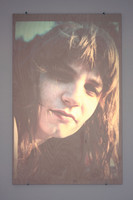
Potential K, 2011, 41 color and black and white slides, dimensions variable, installation view exhibition "wo sind wir jetzt" with Andreas Koch at Kunstverein Arnsberg, 2013
Potential K (2011) is a slide show whose photographs were taken over the course of eleven years. The multifaceted portrait of a friend of the artist’s focuses on the trusting intimacy between the two of them. This piece asks what insight we gain through the portrait of someone who shares a close relationship with the portrayer.
Für ihre Dia-Serie „Potential K“ versammelt Hoffmann Aufnahmen von einer nahen Freundin: Portrait-Aufnahmen, Schnappschüsse und Studiofotos aus den letzten elf Jahren. Immer wieder in Hoffmanns Arbeit speisen sich die Bilder aus ihrem Fotoarchiv, welches sie als lebendiges Materiallager ständig aufs Neue durchforstet. „Potential K“ ist der Versuch, das Portrait als Genre durch Mannigfaltigkeit zu erweitern und der Repräsentation des einen Wahren zu widersprechen. Die Arbeit scheint zu sagen: wir sind viel, jeder Einzelne von uns.
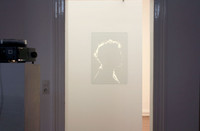
wer wir sind und waren, 2012, 81 color and black and white slides on glass, dimensions variable, installation view exhibition "wo sind wir jetzt" with Andreas Koch at Kunstverein Arnsberg, 2013
Die Künstlerin Nina Hoffmann richtet den Blick auf das für sie Wesentliche: die Menschen in ihrem Umfeld. Ihre fotografischen Arbeiten für die Ausstellung „wo sind wir jetzt“ sind in den letzten vier Jahren entstanden und behaupten das Portrait als Beziehung zwischen Fotografin und Fotografiertem.
Hoffmanns Arbeiten bestechen neben ihrer inhaltlichen Wärme und Nähe durch ihre Installation. In ihrer Arbeit „wer sind wir und waren“ projiziert sie Lichtprofile auf Glas. „Alphabet KS“ ist ein stillstehendes Schwarzweiß- Dia; beide Projektionen passieren bei Tageslicht. Hoffmann lässt uns durch ihre eingesetzte Technik oft fragen, wodurch das gezeigte Bild generiert wird; wo ist deren Quelle? Damit unterstreicht sie subtil ihr inhaltliches Interesse: wie machen wir uns ein Bild von einander?
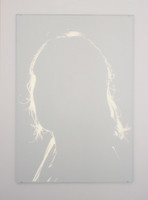
wer wir sind und waren, 2012, 81 color and black and white slides on glass, dimensions variable, installation view exhibition "wo sind wir jetzt" with Andreas Koch at
Kunstverein Arnsberg, 2013
Die Künstlerin Nina Hoffmann richtet den Blick auf das für sie Wesentliche: die Menschen in ihrem Umfeld. Ihre fotografischen Arbeiten für die Ausstellung „wo sind wir jetzt“ sind in den letzten vier Jahren entstanden und behaupten das Portrait als Beziehung zwischen Fotografin und Fotografiertem.
Hoffmanns Arbeiten bestechen neben ihrer inhaltlichen Wärme und Nähe durch ihre Installation. In ihrer Arbeit „wer sind wir und waren“ projiziert sie Lichtprofile auf Glas. „Alphabet KS“ ist ein stillstehendes Schwarzweiß- Dia; beide Projektionen passieren bei Tageslicht. Hoffmann lässt uns durch ihre eingesetzte Technik oft fragen, wodurch das gezeigte Bild generiert wird; wo ist deren Quelle? Damit unterstreicht sie subtil ihr inhaltliches Interesse: wie machen wir uns ein Bild von einander?

Installation View of Exhibition "wo sind wir jetzt" with Andreas Koch at Kunstverein Arnsberg, 2013
Die Künstlerin Nina Hoffmann richtet den Blick auf das für sie Wesentliche: die Menschen in ihrem Umfeld. Ihre fotografischen Arbeiten für die Ausstellung „wo sind wir jetzt“ sind in den letzten vier Jahren entstanden und behaupten das Portrait als Beziehung zwischen Fotografin und Fotografiertem.
Hoffmanns Arbeiten bestechen neben ihrer inhaltlichen Wärme und Nähe durch ihre Installation. In ihrer Arbeit „wer sind wir und waren“ projiziert sie Lichtprofile auf Glas. „Alphabet KS“ ist ein stillstehendes Schwarzweiß- Dia; beide Projektionen passieren bei Tageslicht. Hoffmann lässt uns durch ihre eingesetzte Technik oft fragen, wodurch das gezeigte Bild generiert wird; wo ist deren Quelle? Damit unterstreicht sie subtil ihr inhaltliches Interesse: wie machen wir uns ein Bild von einander?
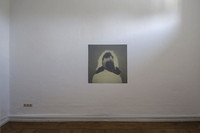
Alphabet (KS), day light slide projektion, size variable, 2010
Installation View of Exhibition "wo sind wir jetzt" with Andreas Koch at Kunstverein Arnsberg, 2013
Die Künstlerin Nina Hoffmann richtet den Blick auf das für sie Wesentliche: die Menschen in ihrem Umfeld. Ihre fotografischen Arbeiten für die Ausstellung „wo sind wir jetzt“ sind in den letzten vier Jahren entstanden und behaupten das Portrait als Beziehung zwischen Fotografin und Fotografiertem.
Hoffmanns Arbeiten bestechen neben ihrer inhaltlichen Wärme und Nähe durch ihre Installation. In ihrer Arbeit „wer sind wir und waren“ projiziert sie Lichtprofile auf Glas. „Alphabet KS“ ist ein stillstehendes Schwarzweiß- Dia; beide Projektionen passieren bei Tageslicht. Hoffmann lässt uns durch ihre eingesetzte Technik oft fragen, wodurch das gezeigte Bild generiert wird; wo ist deren Quelle? Damit unterstreicht sie subtil ihr inhaltliches Interesse: wie machen wir uns ein Bild von einander?

Urban Mysteries
Collaboration with Kathrin Sonntag
Billboard Posters at the Subway Station Kurfürstenstraße through March 2013
Part of the Project "Kunst im Untergrund" initiated by NGBK
German Press Release: Seit Jahren schreiben die Künstlerinnen Nina Hoffmann und Kathrin Sonntag kuriose Beobachtungen aus ihrem Alltag auf. In der Bewegung durch eine Großstadt kommt es zu einem ständigen, bewussten und unbewussten Abgleichen mit sich und der Umwelt. Wie würde ich das machen? In was für einer Situation befindet sich der andere Mensch? Wo kommt er her und wo geht sie hin? Auf Grund der sehr kurzen Eindrücke öffnet sich ein riesiger imaginärer Raum. Viele der Ereignisse geschehen in Transit, auf dem Weg durch die Stadt, in einem Moment der zerstreuten Kontemplation, in dem die Aufmerksamkeit plötzlich von etwas gefesselt wird. Für „Kunst im Untergrund“ werden drei von Hoffmann und Sonntags Geschichten als typografische Bilder auf die Plakatflächen angebracht.
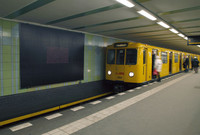
Urban Mysteries
Collaboration with Kathrin Sonntag
Billboard Posters at the Subway Station Kurfürstenstraße through March 2013
Part of the Project "Kunst im Untergrund" initiated by NGBK
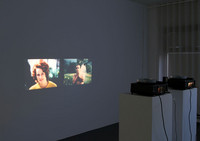
Fundament, 2012, double slide projection, 2 x 78 color slides, size variable, installation view exhibition "Über Dich" at Galerie Kamm, Berlin
Fundament (2012) by Nina Hoffmann shows two different ways of dealing with being filmed. We see two synchronized image sequences of a man and a woman taking turns to film each other. Initially unaware, the protagonists only notice that they are being filmed by looking into the camera. Nina Hoffmann is interested in this particular moment when both show a spontaneous reaction to deal with the situation. The protagonists are the artist’s parents, which triggers further appealing crossovers at those moments when Nina Hoffmann herself is visible in the image through mirror reflections. This way, the artist includes herself in the image.
Die Arbeit Fundament (2012) von Nina Hoffmann zeigt zwei unterschiedliche Arten mit dem Gefilmtwerden umzugehen. Zu sehen sind zwei synchronisierte Bildsequenzen, die jeweils einen Mann und eine Frau zeigen, die sich wechselseitig filmen. Zunächst unbemerkt, erkennen die Dargestellten erst durch ihren Blick in die Kamera, dass sie aufgenommen werden. Nina Hoffmann interessiert genau dieser Moment, in dem sich bei beiden eine spontane Reaktion zeigt, mit der Situation umzugehen. Bei den Abgebildeten handelt es sich um die Eltern der Künstlerin und so kommt es zu weiteren reizvollen Überkreuzungen an den Stellen, da Nina Hoffmann in Form von Spiegelungen selbst im Bild zu erkennen ist. Die Künstlerin, welche aus dem privaten Material mit einem analytischen Blick auswählt, schreibt sich auf diese Weise selbst ins Bild mit ein.
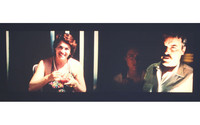
Fundament, 2012, double slide projection, 2 x 78 color slides, size variable
Fundament (2012) by Nina Hoffmann shows two different ways of dealing with being filmed. We see two synchronized image sequences of a man and a woman taking turns to film each other. Initially unaware, the protagonists only notice that they are being filmed by looking into the camera. Nina Hoffmann is interested in this particular moment when both show a spontaneous reaction to deal with the situation. The protagonists are the artist’s parents, which triggers further appealing crossovers at those moments when Nina Hoffmann herself is visible in the image through mirror reflections. This way, the artist includes herself in the image.
Die Arbeit Fundament (2012) von Nina Hoffmann zeigt zwei unterschiedliche Arten mit dem Gefilmtwerden umzugehen. Zu sehen sind zwei synchronisierte Bildsequenzen, die jeweils einen Mann und eine Frau zeigen, die sich wechselseitig filmen. Zunächst unbemerkt, erkennen die Dargestellten erst durch ihren Blick in die Kamera, dass sie aufgenommen werden. Nina Hoffmann interessiert genau dieser Moment, in dem sich bei beiden eine spontane Reaktion zeigt, mit der Situation umzugehen. Bei den Abgebildeten handelt es sich um die Eltern der Künstlerin und so kommt es zu weiteren reizvollen Überkreuzungen an den Stellen, da Nina Hoffmann in Form von Spiegelungen selbst im Bild zu erkennen ist. Die Künstlerin, welche aus dem privaten Material mit einem analytischen Blick auswählt, schreibt sich auf diese Weise selbst ins Bild mit ein.
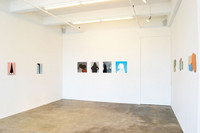
Installation Shot "Reflecting Abstraction" at Vogt Gallery in New York, 2011, with Sadie Benning, Abigail Deville
and Ulrike Müller, curated by Dean Daderko
Clarice Lispector said “the smallest piece of a mirror is always the whole mirror.”
Is it also true that the smallest piece of a body is always, somehow, the whole
body?
The use of figural or anatomic references in a work of art can offer viewers the
opportunity to imagine themselves or other bodies in a place that is otherwise
undefined. This is a space of possibility, where new ways of being in the world
can be experimented with, and where a body can be free of the limitations
imposed on it.
...a body, the body, her body, your body...
Abstraction functions in an active space somewhere between object and mirror. It
allows viewers a chance to see themselves, or a portion or aspect of themselves,
as part of a bigger picture. Reflecting Abstraction investigates painting and
photography’s abstract engagements with the figure and the shifting subjective
positions that these relationships outline.
Dean Daderko
Brooklyn, 2011
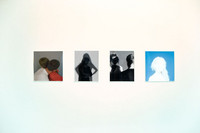
Installation Shot "Reflecting Abstraction" at Vogt Gallery in New York, 2011, with Sadie Benning, Abigail Deville
and Ulrike Müller, curated by Dean Daderko
Clarice Lispector said “the smallest piece of a mirror is always the whole mirror.”
Is it also true that the smallest piece of a body is always, somehow, the whole
body?
The use of figural or anatomic references in a work of art can offer viewers the
opportunity to imagine themselves or other bodies in a place that is otherwise
undefined. This is a space of possibility, where new ways of being in the world
can be experimented with, and where a body can be free of the limitations
imposed on it.
...a body, the body, her body, your body...
Abstraction functions in an active space somewhere between object and mirror. It
allows viewers a chance to see themselves, or a portion or aspect of themselves,
as part of a bigger picture. Reflecting Abstraction investigates painting and
photography’s abstract engagements with the figure and the shifting subjective
positions that these relationships outline.
Dean Daderko
Brooklyn, 2011

Alphabet(KJ), 2010, c-print
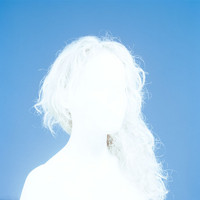
Alphabet(Au), 2010, c-print

Alphabet(NM), 2010, black and white print

Alphabet(MS), 2010, black and white print

Motiv, 2009, Slide Projection
Installation View "Leopards in the Temple", Sculpture Center, New York
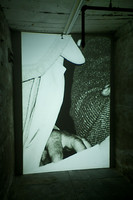
Motiv, 2009, Slide Projection
Installation View "Leopards in the Temple", Sculpture Center, New York
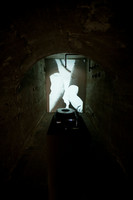
Motiv, 2009, Slide Projection
Installation View "Leopards in the Temple", Sculpture Center, New York

Invitation for Double Fantasy, with Norbert Witzgall at Samsa, November 2009
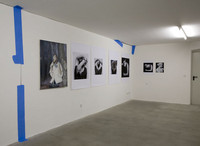
Installation Shot Double Fantasy, with Norbert Witzgall at Samsa, November 2009

Alphabet(u), black and white print, 70 x 70 cm, 2009
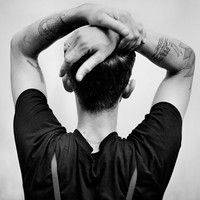
Alphabet(U), black and white print, 50 x 50 cm, 2009
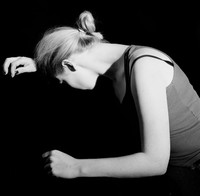
Alphabet(a), black and white print, 80 x 80 cm, 2009
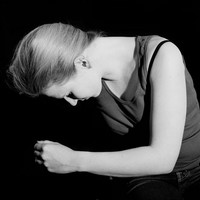
Alphabet(A), black and white print, 40 x 40 cm, 2009
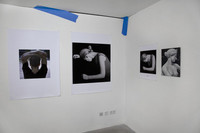
Installation Shot Double Fantasy, with Norbert Witzgall at Samsa, November 2009
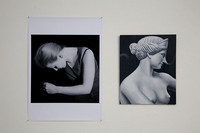
Installation Shot Double Fantasy, with Norbert Witzgall at Samsa, November 2009

Installation Shot Double Fantasy, with Norbert Witzgall at Samsa, November 2009
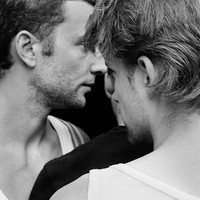
Alphabet(JFT), black and white print, 40 x 40 cm, 2009
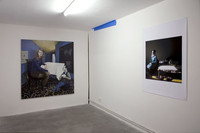
Installation Shot Double Fantasy, with Norbert Witzgall at Samsa, November 2009

Untitled(Elisabeth), c-print, 80 x 80 cm, 2009
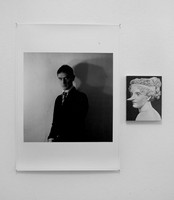
Installation Shot Double Fantasy, with Norbert Witzgall at Samsa, November 2009
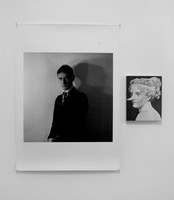
Installation Shot Double Fantasy, with Norbert Witzgall at Samsa, November 2009

untitled (Kafka)
black and white print, 2008
size variable
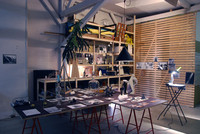
Lager, Installation View "Neues Museum" at Basso,
Collaboration with Kathrin Sonntag, Jakob Schaible, Sophie-Therese Trenka-Dalton, Gabriell Rossel Santillan, Jan Molzberger and many others, Installation Shot: Sophie-Therese Trenka-Dalton
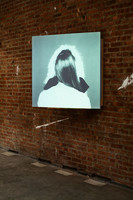
Untitled (KS), 2009, Single Slide Daylight Projection
Installation View "Leopards in the Temple", Sculpture Center, New York
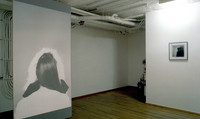
Installation View "slang is signing is signals" at Souterrain

untitled (Baga)
1,20 m x 1,20 m
black and white print,
2009
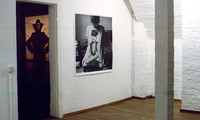
Installation View "slang is signing is signals" at Souterrain

Installation View "slang is signing is signals" at Souterrain

Installation View "slang is signing is signals" at Souterrain

Installation View "slang is signing is signals" at Souterrain

Installation View "slang is signing is signals" at Souterrain
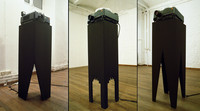
Installation View "slang is signing is signals" at Souterrain
Slide Stands
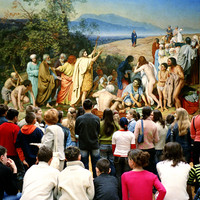
untitled (Moskau)
2006, c-print, 120 cm x 120 cm
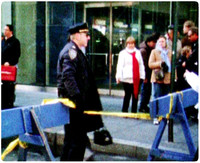
A Stage, A Frame, a Fence, A Fantasy
(Videostill)
Super8 on DVD, 16:35 min, 2008

A Stage, A Frame, a Fence, A Fantasy
(Videostill)
Super8 on DVD, 16:35 min, 2008
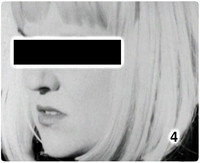
A Stage, A Frame, a Fence, A Fantasy
(Videostill)
Super8 on DVD, 16:35 min, 2008

A Stage, A Frame, a Fence, A Fantasy
(Videostill)
Super8 on DVD, 16:35 min, 2008
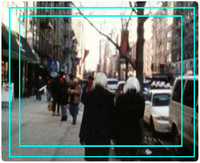
A Stage, A Frame, a Fence, A Fantasy
(Videostill)
Super8 on DVD, 16:35 min, 2008
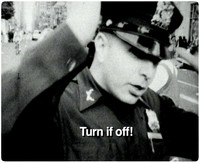
A Stage, A Frame, a Fence, A Fantasy
(Videostill)
Super8 on DVD, 16:35 min, 2008

A Stage, A Frame, a Fence, A Fantasy
(Videostill)
Super8 on DVD, 16:35 min, 2008
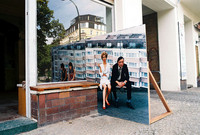
Luckalaik
Installation View at TÄT
C-print mounted on board, 2007, size variable
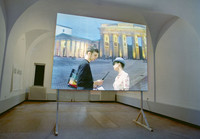
Blue Box Berlin
Installation View
miniDV on DVD, 2005, 10:20 min
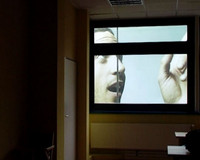
Blue Box Berlin
(Videostill)
miniDV on DVD, 2005, 10:20 min

Blue Box Berlin
(Videostill)
miniDV on DVD, 2005, 10:20 min

Blue Box Berlin
(Videostill)
miniDV on DVD, 2005, 10:20 min
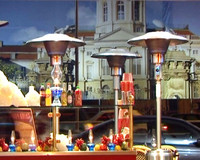
Blue Box Berlin
(Videostill)
miniDV on DVD, 2005, 10:20 min
